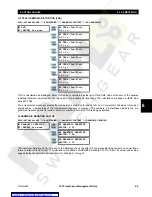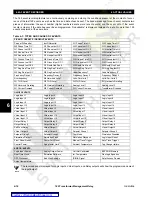
GE Multilin
745 Transformer Management Relay
7-1
7 COMMUNICATIONS
7.1 OVERVIEW
7
7 COMMUNICATIONS 7.1OVERVIEW
7.1.1 PROTOCOLS
The GE Multilin 745 Transformer Management Relay communicates with other computerized equipment such as program-
mable logic controllers, personal computers, or plant master computers using either the AEG Modicon Modbus protocol or
the Harris Distributed Network Protocol (DNP), Version 3.0. Following are some general notes:
•
The 745 relay always act as slave devices meaning that they never initiate communications; they only listen and
respond to requests issued by a master computer.
•
For Modbus, a subset of the Remote Terminal Unit (RTU) format of the protocol is supported which allows extensive
monitoring, programming and control functions using read and write register commands.
•
For DNP, the functionality is restricted to monitoring of essential relay data and control of important relay functions. A
complete description of the services available via DNP may be found in the Device Profile Document which is included
in this chapter.
DNP is a complex protocol. As a consequence, it is not possible within the scope of this manual to provide a description of
the protocol's operation in anything approaching the detail required to understand how to use it to communicate with the
relay. It is strongly recommended that interested users contact the DNP Users Group at
www.dnp.org
to obtain further
information:
Members of the DNP Users Group are eligible to receive complete descriptions of all aspects of the protocol. The Users
Group also operates a website (
www.dnp.org
) where technical information and support is available.
7.1.2 PHYSICAL LAYER
Both the Modbus and DNP protocols are hardware-independent so that the physical layer can be any of a variety of stan-
dard hardware configurations including RS232, RS422, RS485, fiber optics, etc. The 745 includes a front panel RS232 port
and two rear terminal RS485 ports, one of which can also be configured as RS422. Data flow is half duplex in all configura-
tions. See Section 3.2.15: RS485 / RS422 Communications on page 3–12 for details on wiring.
Each data byte is transmitted in an asynchronous format consisting of 1 start bit, 8 data bits, 1 stop bit, and possibly 1 parity
bit. This produces a 10 or 11 bit data frame. This is important for transmission through modems at high bit rates (11 bit data
frames are not supported by many modems at baud rates greater than 300).
The baud rate and parity are independently programmable for each communications port. Baud rates of 300, 1200, 2400,
4800, 9600, and 19200 are available. Even, odd, and no parity are available. See Section 5.3.3: Communications on page
5–24 for further details.
The master device in any system must know the address of the slave device with which it is to communicate. The 745 will
not act on a request from a master if the address in the request does not match the relay's slave address (unless the
address is the broadcast address -- see below).
A single setpoint selects the slave address used for all ports with the exception that for the front panel port the relay will
accept any address when the Modbus protocol is used. The slave address is otherwise the same regardless of the protocol
in use, but note that the broadcast address is 0 for Modbus and 65535 for DNP. The relay recognizes and processes a
master request (under conditions that are protocol-specific) if the broadcast address is used but never returns a response.
DNP may be used on, at most, one of the communications ports. Any port(s) not selected to use DNP will communicate
using Modbus. The
S1 RELAY SETUP
ÖØ
DNP
Ö
DNP PORT
setpoint is used to select which port will communicate using DNP.
The maximum time for a 745 relay to return a response to any (non-broadcast) master request never exceeds 1 second.
Содержание TRANSFORMER MANAGEMENT RELAY 745
Страница 2: ...Courtesy of NationalSwitchgear com ...
















































